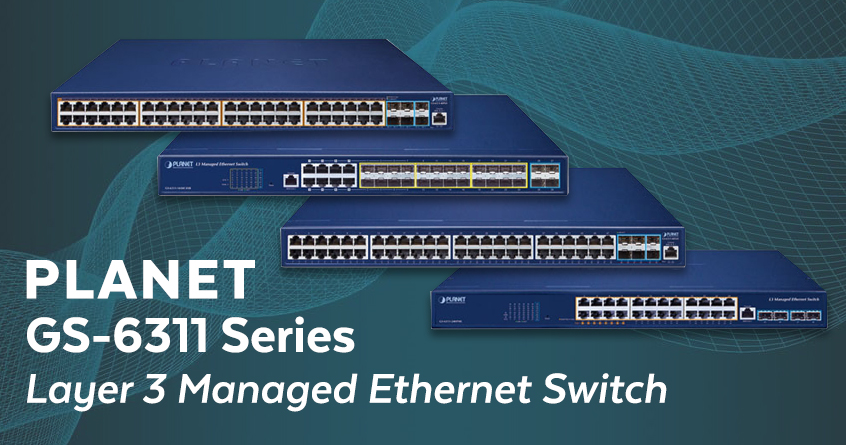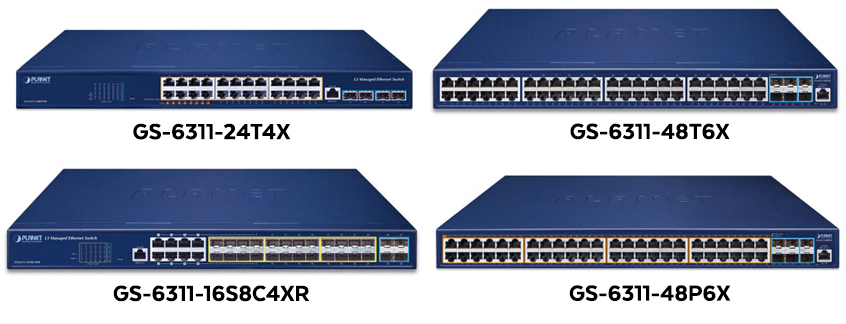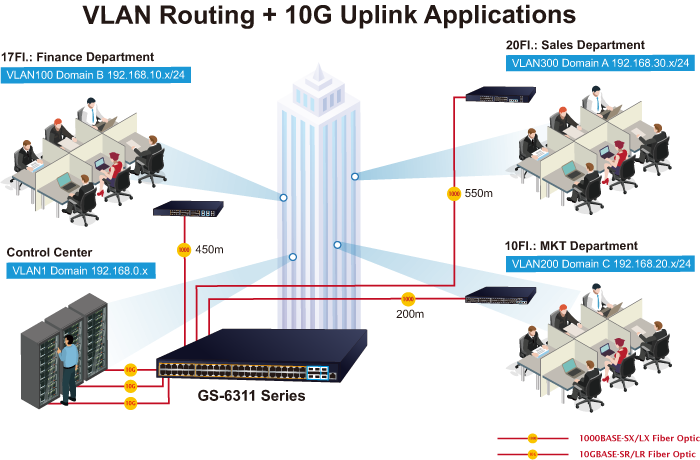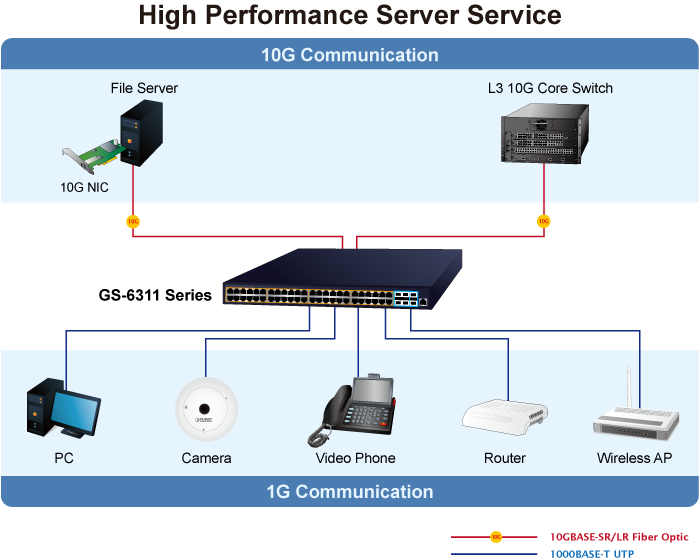In today’s business landscape, reliable and efficient network infrastructure is critical for competing in a network-dependent world. The Planet GS-6311 Series Layer 3 Managed Ethernet Switch is a powerful and versatile solution that meets today’s networking requirements. Take a journey with us as we explore the key features and capabilities of this advanced Layer 3 managed switch.
What is The Planet GS-6311 Series?
The Planet GS-6311 Series represents a significant advancement in network switching technology. It offers many features and capabilities to enhance network performance, security, and manageability. Some key features that make the product stand out are:
- Layer 3 Static Routing: Layer 3 routing capabilities enable this switch to make intelligent routing decisions at the network layer. This feature is crucial for optimizing the flow of data and ensuring efficient traffic management.
- 10Gbps Interfaces: With 10Gbps interfaces, the GS-6311 Series offers lightning-fast data transfer speeds, making it ideal for applications that demand high bandwidth.
- Secure Topology: Security is paramount in modern networks. The GS-6311 Series offers secure topology management, safeguarding your data from potential threats and unauthorized access.
This one-of-a-kind Layer 3 managed switch has been engineered to deliver high performance, flexibility, and scalability for businesses of all sizes. Whether you are setting up a small office network or a large-scale enterprise infrastructure, Planet GS-6311 can adapt to your needs.
GS-6311 Series Models
The Planet GS-6311 Series Layer 3 Multigigabit Switch comes in four distinct models, each designed for different networking environments:
- GS-6311-24T4X: Ideal for networks that balance high-speed 10G SFP connectivity and ample 10/100/1000T ports.
- GS-6311-48T6X: Tailored for environments that require a greater number of 10/100/1000T ports and more robust 10G SFP options.
- GS-6311-16S8C4XR: Perfect for setups requiring a combination of high-speed SFP ports, gigabit TP/SFP ports, and reliable power options.
- GS-6311-48P6X: Designed for networks with Power over Ethernet (PoE) requirements, featuring 48 PoE-enabled ports and multiple 10G SFP ports.
Select the model that best suits your network’s demands and experience the power, speed, and efficiency of the GS-6311 Series Layer 3 Multigigabit Switch.
What Does It Do?
The capabilities of the GS-6311 Series extend beyond its impressive technical specifications. It offers a variety of functions that will facilitate more efficient data communication and network management. Here’s what the GS-6311 can do:
- Switching: Like traditional Layer 2 switches, the GS-6311 performs Ethernet switching. It connects devices within the same network segment, enabling them to communicate directly with each other.
- Multicast Communication: The GS-6311 supports multicast, efficiently distributing data to multiple destinations simultaneously. This efficient approach minimizes network bandwidth usage, as data is transmitted only once over shared network segments.
- Energy Efficiency: Designed with energy-saving technologies, the GS-6311 can automatically adjust power consumption based on network traffic and cable length. This feature reduces energy costs and minimizes the network’s environmental footprint.
- Management: Managed switches provide a user-friendly web-based management interface for administrators to configure and monitor their switches. These products also support network management protocols like SNMP and RMON for more advanced monitoring capabilities.
In an era where data is king, the GS-6311 Series provides organizations with a reliable, high-performance networking solution.
Where Is the GS-6311 Layer 3 Managed Switch Used?
The GS-6311 Layer 3 Managed Switch is best suited for networking environments where its cutting-edge capabilities can be fully utilized. Some common use cases for the GS-6311 switch include:
- Enterprise Backbone: The GS-6311 is well-suited for serving as the backbone of large enterprise networks. Its Layer 3 routing capabilities enable efficient traffic management between different organizational departments, floors, or buildings. With advanced routing features and high-speed ports, the switch is ideal for handling data traffic in such environments. These capabilities help ensure seamless communication and data transfer between various parts of enterprise networks.
- Data Centers: Data centers require high-performance networking equipment to support rapid data transfer between servers and storage devices. Its Multi-Gigabit and 10G SFP ports are ideal for connecting servers and network-attached storage (NAS) devices, ensuring low latency and high-speed data transfers.
- High-Capacity Servers: The switch’s 10Gbps interface allows it to move large volumes of data quickly and efficiently. This capacity makes it an excellent option for connecting to high-capacity servers in data centers hosting data-intensive applications and services.
- Video Surveillance: The switch’s high-density performance and secure topography make it perfect for video surveillance applications. It can handle the data traffic generated by multiple IP cameras, ensuring reliable and secure video surveillance within an organization.
The Planet GS-6311 Layer 3 Managed Switch is valuable for organizations with diverse networking needs due to its high-speed capabilities, Layer 3 routing, and security features.
What Does a Backbone Mean in Networking?
In networking terminology, the term backbone refers to the core infrastructure that connects various parts of a network. It acts as a central pathway for data traffic, ensuring efficient communication between network segments. The backbone network is typically designed with high-speed, high-capacity links and devices to handle large data traffic volumes. It is a critical means of providing connectivity within and between organizations, data centers, and even on a global scale, such as the Internet. The backbone network is essential for directing data to its destination, optimizing traffic flow, and ensuring data reaches its intended recipients. The backbone is essential for maintaining network stability and performance.
What Is Multicast Used For?
Multicast is a network communication method particularly useful for applications like audio/video streaming broadcasts. It allows a single source to send data to a multicast address, where it is then distributed to multiple recipients simultaneously. This efficient data distribution method is essential for scenarios where content needs to be delivered to a group of users simultaneously.
By supporting multicast, the GS-6311 switch enhances network efficiency, reduces data replication, and optimizes data delivery to multiple recipients. These benefits make it a valuable asset in various networking scenarios where one-to-many or many-to-many communication is essential.
Why Are IP Routing Features Important?
IP routing features are vital because they determine how data packets are directed through a network. Efficient routing ensures that data reaches its intended destination with speed and reliability. In modern networks, where data traffic is often complex and extensive, effective IP routing features are essential for optimal network performance and security.
One of the primary functions of the GS-6311 is routing at Layer 3 of the OSI model. This capability allows the switch to intelligently route traffic between different subnets or network segments, facilitating efficient communication between devices and ensuring data reaches its intended destination.
What Are OSI Layers and Some of the Layer 2 Features?
The OSI (Open Systems Interconnection) model is a conceptual framework that standardizes the functions of a telecommunications or networking system into seven distinct layers.
Layer 2, also known as the Data Link Layer, provides node-to-node communication and addressing via MAC addresses. Layer 2 features often include:
- Ethernet frame handling.
- VLAN support.
- MAC address learning.
Why Is Layer 3 Significant?
Layer 3, the Network Layer in the OSI model, is so important because it handles routing and logical addressing, enabling devices to communicate across different networks. Layer 3 devices, like the GS-6311 Series, are a crucial intermediary, determining how data packets are forwarded between networks. These devices are a fundamental component of any modern networking infrastructure.
Elevate Your Network with the Planet GS-6311: The Ultimate Layer 3 Multigigabit Switch
Whether you are looking to improve network performance, enhance security, or accommodate the growing demands of your organization, the GS-6311 Series is a powerful tool that can help you achieve your networking goals. Selecting this product represents a smart investment in the future of your business and will ensure that your network can adapt and scale as your needs evolve.
Refer to the official product documentation to learn more about the Planet GS-6311 Series Layer 3 Managed Ethernet Switch and explore its full list of features. Upgrading your network infrastructure today is a crucial step towards ensuring that you stay ahead of the curve in the rapidly evolving world of technology.



